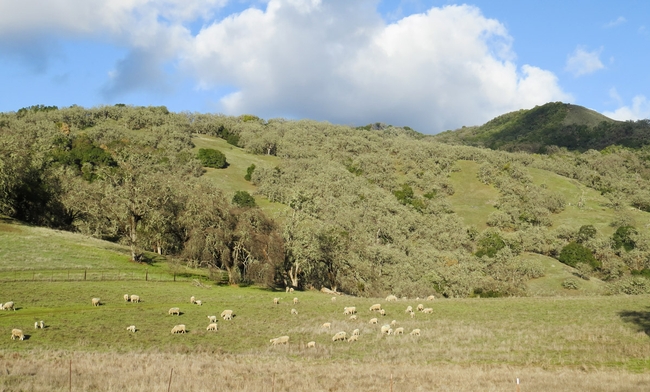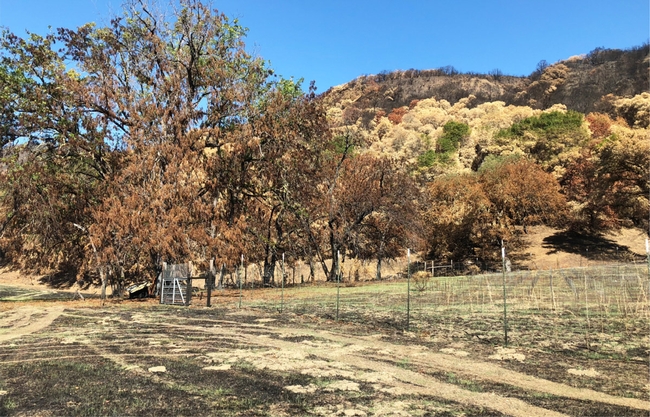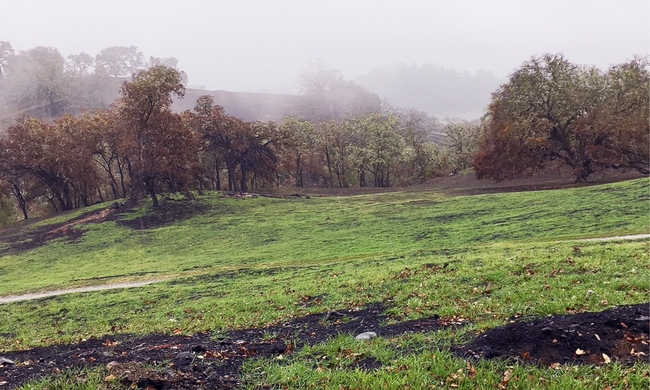
Posts Tagged: toxic
Lambs grazing on pastures after wildfire show no significant adverse effects
Hopland REC turns 2018 River Fire devastation into research opportunity
The destructiveness of wildfire flames is easy to see, but dangers may lurk in the ashes they leave behind. A group of UC Davis scientists studied lambs at the UC Hopland Research and Extension Center, investigating whether pastures regrown after a wildfire cause toxic metal residues in grazing animals. The results, published in California Agriculture journal, showed that grazing on regrown pastures did not significantly alter the metal content of the lambs' meat and wool. That's good news for ranchers and consumers from a food safety perspective.
In 2018, the River Fire burned six miles north of Hopland, scorching two-thirds of the land at Hopland REC, including areas in its sheep station. Since Hopland REC conducts ecological and agricultural research, they had data and some meat samples from the sheep flock that lived on site before the River Fire occurred.
“A bunch of researchers came together to brainstorm how we could take advantage of this unfortunate event,” said Sarah Depenbrock, assistant professor and agronomist in the Medicine and Epidemiology department of UC Davis School of Veterinary Medicine.
Burning has played a role in agricultural processes for many years, but wildfires in California are creating a new fire landscape that interests researchers like Depenbrock. “The problem, now, is that these big wildfires probably interact with agricultural land differently than routine prescribed burns,” she said.
Large, older plants on lands that have not recently burned may contain high concentrations of metals, sequestered over years of growth. Mercury is an example of a potentially dangerous metal that can be sequestered in living things over time. These metals may be distributed in ash after the vegetation burns so the scientists examined lambs that had grazed on Hopland REC's recently burned pastures, during the first plant regrowth.
Uncertain results raise more questions
The researchers compared meat from lambs that grazed on regrown pastures in 2019, after the River Fire, to frozen meat samples that were collected the year before the fire. Lead, mercury, arsenic, molybdenum, cadmium, beryllium, cobalt and nickel were not detected in any animal samples. There were, however, a few (3 out of 26) samples that tested positive for the non-essential (potentially toxic heavy metals) chromium and thallium in the group grazing after the fire.
Due to the small number of samples testing positive, researchers could not determine statistically if this contamination was associated with grazing the burn regrowth. The concentrations of chromium and thallium found may or may not be potentially toxic, depending on the specific forms and how much meat a person consumes.
Another aspect of the study included testing lambs' wool to determine if it is a good method of judging the mineral content of its meat. “In general, we learned that it wasn't well-correlated with most meat metal content of interest, which is worth knowing. However, because we did not identify many of the non-essential metals of particular toxologic concern, such as lead or mercury, in any animal samples we could not determine if testing wool would be useful for those metals, as they are in other species,” said Depenbrock. She also notes that the wool from animals whose meat tested positive for chromium and thallium, did not test positive for these metals in their wool.
As the challenges in managing wildfires persist, so does the risk of contamination of food products stemming from grazing livestock.
“We didn't get striking evidence that tells us, when there's a fire, it means everything is contaminated with heavy metals,” said Depenbrock. “But it does raise the question that maybe we should be doing a little bit of surveillance to see if this is spurious or common. And we should be finding a way to screen grazing herds.”
Recommendations to manage copper concerns
“It's a very small study, but it was quite interesting to find that copper was actually lower in the postfire grazing group, which makes me wonder,” Depenbrock said.
Diseases associated with copper deficiency are a major concern in sheep. For example, congenital swayback can result in stillbirth or an animal's inability to stand on its own due to incurable changes to the spinal cord. Other adverse effects include reduced growth rate, anemia, wool defects and fiber depigmentation, and osteoporosis with higher risk of spontaneous fractures. Copper excess can also cause serious and sometimes fatal disease.
Many of the forage sources, grazing areas and rangelands in California are copper deficient, while some feed sources have excess copper. Screening and monitoring livestock herds for trace minerals including copper is crucial.
To test for copper, she advises livestock owners to obtain mineral concentrations from the organs of euthanized or dead animals. Samples from the liver and kidney are the most valuable organs to identify a potential problem in the herd. UC Davis Veterinary Medicine's California Animal Health and Food Safety (CAHFS) labs do this testing routinely.
Second, monitor and record mineral supplementation and, third, maintain updated health records to make informed decisions regarding supplementation based on a herd or flock's known problems. For example, if a producer is not accustomed to supplementing copper, Depenbrock highly recommends working with a veterinarian to start out (as there are numerous copper supplement products of varying concentration on the market), to determine a testing or screening plan, and review health records for problems potentially associated with copper.
To read the full text of the study, visit https://calag.ucanr.edu/Archive/?article=ca.2022a0016.
Is vetch a friend or foe to livestock?
From the Alfalfa & Forage News blog (April 29, 2022) Vetch (Vicia spp.) is growing like a weed everywhere this year, carpeting our hills with great swaths of purple flowers. What is vetch? There are several species that are commonly grown as crops, cover crops or weeds...
Jared Ali: 'Bad Bugs, Pungent Parasites and Toxic Travelers'
Fantastic title: "Bad Bugs, Pungent Parasites and Toxic Travelers!" Don't you just love that alliteration? Jared Ali, an assistant professor at Pennsylvania State University, will speak on "Chemical Ecology of Plant Defense and Multi-Trophic Interactions: Bad Bugs, Pungent Parasites...
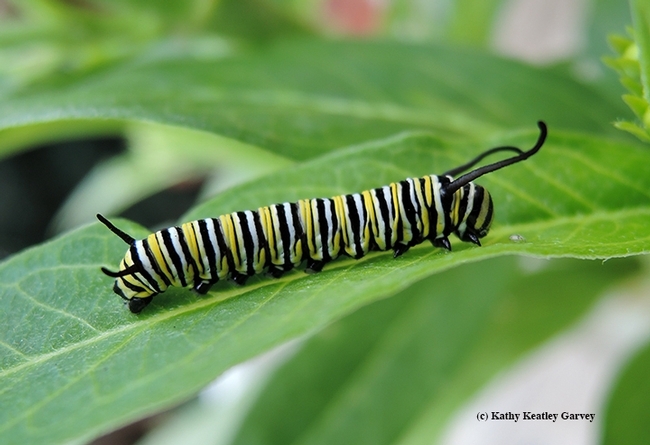
The monarch caterpillar will be among the topics that seminar speaker Jared Ali will discuss at the UC Davis Department of Entomology and Nematology in-person and virtual seminar at 4:10 p.m., Wednesday, April 20. (Photo by Kathy Keatley Garvey)
Giant hogweed in the news
Invasive plants don't get much coverage in the news, especially at the state and national level. As I've argued previously, this lack of media attention is a problem when it comes to motivating the public and political players into proactively funding invasive plant management and mitigating...
Garden writer streams advice on toxic plants
In a 1,500-word stream of consciousness, Bakersfield Magazine gardening writer Lynn Pitts warned her readers about the dangers of certain "toxic plants."
Sprinkled among personal experiences, trivia and witticisms, Pitts presented the 10 most common toxic plants found in local gardens: Oleander, tomatoes, potatoes, rhubarb, delphinium, boxwood, pyracantha, fig, foxglove and castor bean.
Among her words of wisdom:
- Oleander cuttings shouldn't be disposed of in green waste cans.
- Almost everything on tomato and potato plants are poisonous, expect the tomato and potato.
- Rhubarb leaves are toxic.
- The leaves and sap of fig trees cause dermatitis.
- Foxglove is the source of the heart medicine digitalis.
- Nefarious people have concocted the poison “ricin” from castor bean.
UC Cooperative Extension enters the story in a tangent close to the end, when Pitts writes about a time a wind storm left she and a neighbor flush with fresh olives. Pitts says she called the local University of California Cooperative Extension office for information on home olive curing.
"It wasn’t difficult, but time consuming; changing the brine constantly, rinsing, re-brining over and over. After the last brining, we packed them with fresh herbs and olive oil into sterilized glass canning jars," Pitts wrote. "We thought we’d have plenty of jars to give away as gifts, but, honestly, we ate most of them ourselves!"
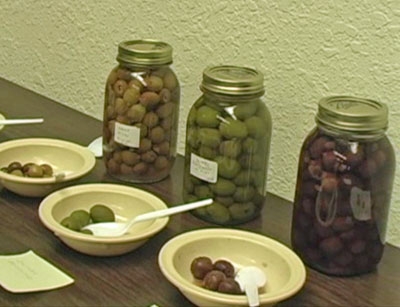
Garden writer steers readers to UCCE for olive curing advice.

